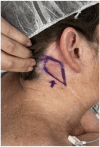Basal Cell Carcinoma Arising in a Previous Full-Thickness Graft Donor Site: A Case Report and Comprehensive Literature Review
- PMID: 39860596
- PMCID: PMC11766017
- DOI: 10.3390/jcm14020591
Basal Cell Carcinoma Arising in a Previous Full-Thickness Graft Donor Site: A Case Report and Comprehensive Literature Review
Abstract
Background/Objectives: Basal cell carcinoma (BCC), the most common skin malignancy, typically occurs in sun-exposed areas but can develop in atypical locations, such as scars, burns, and skin graft donor sites. BCC arising specifically in full-thickness skin graft donor sites is exceptionally rare. This study presents a unique case of BCC occurring 16 years post-graft harvesting and provides a comprehensive literature review to analyze clinical patterns, possible etiopathogenesis, and treatment strategies. Methods: A case report was described and a comprehensive literature review was conducted using PubMed, Scopus, and Web of Science (up to November 2024). Studies were screened for cases of BCC involving skin graft donor and recipient sites. Extracted data included demographics, graft type, latency period, histopathology, treatment, and outcomes. Results: A 68-year-old woman presented with biopsy-confirmed mixed nodular and micronodular BCC at the donor site of a full-thickness skin graft 16 years after its use for nasal reconstruction. Surgical excision with clear margins resulted in complete resolution without recurrence. A literature analysis revealed seven cases of graft-associated BCC, predominantly affecting older females. Partial-thickness grafts were frequently involved, with latency periods ranging from 1 to 61 years. Nodular BCC was the most common histological subtype, and surgical excision remained the primary and most effective treatment. Conclusions: Although rare, BCC can develop in skin graft donor sites after prolonged latency. Chronic trauma, impaired vascularization, and genetic alterations likely contribute to tumorigenesis. Lifelong surveillance, early detection, and timely intervention are critical to improving outcomes.
Keywords: BCC; basal cell carcinoma; full-thickness graft; graft; tumor latency.
Conflict of interest statement
The authors declare no conflicts of interest.
Figures
References
-
- Imbernón-Moya A., Vargas-Laguna E., Lobato-Berezo A., Martínez-Pérez M., Churruca-Grijelmo M., Aguilar-Martínez A., Fernández-Cogolludo E., Gallego-Valdés M. Simultaneous onset of basal cell carcinoma over skin graft and donor site. JAAD Case Rep. 2015;1:244–246. doi: 10.1016/j.jdcr.2015.05.004. - DOI - PMC - PubMed
Publication types
LinkOut - more resources
Full Text Sources


